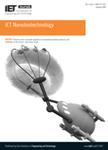版权所有:内蒙古大学图书馆 技术提供:维普资讯• 智图
内蒙古自治区呼和浩特市赛罕区大学西街235号 邮编: 010021

作者机构:JK Lakshmipat Univ Inst Engn & Technol Jaipur Rajasthan India Sharda Univ Sch Basic Sci & Res Mat Res Lab Greater Noida India Guru Gobind Singh Indraprastha Univ Univ Sch Basic & Appl Sci Mesoporous Syst & Nanocomposites Res Lab New Delhi India Banaras Hindu Univ Dept Phys MMV Varanasi Uttar Pradesh India
出 版 物:《IET NANOBIOTECHNOLOGY》 (IET纳米生物技术)
年 卷 期:2019年第13卷第4期
页 面:363-367页
核心收录:
学科分类:0710[理学-生物学] 0808[工学-电气工程] 08[工学] 0805[工学-材料科学与工程(可授工学、理学学位)]
主 题:transmission electron microscopy infrared spectra nanomagnetics pyrolysis decomposition adsorption desorption carbon nanotubes differential thermal analysis thermal analysis nanofabrication Raman spectra X-ray diffraction scanning electron microscopy paramagnetic materials biogenic synthesis highly porous carbon nanotubes microorganisms high-temperature decomposition technique cobalt salt chicken fats fatty acids short hydrocarbon chains Raman spectra graphite mode G-band structural imperfections defect mode D-band transmission electron microscopy paramagnetic nature thermo-magnetic properties poultry waste nitrogen adsorption-desorption studies thermogravimetry analysis differential thermal analysis carbon nanotubes temperature 517 0 degC C
摘 要:Nanomaterials synthesis using natural sources is the technology to up come with advanced materials through extracts of plant, microorganisms, poultry waste etc. In this study, the authors report the synthesis of porous carbon nanotubes using high-temperature decomposition technique facilitated by cobalt salt using chicken fats, a poultry waste as a precursor. Since chicken fats contain fatty acids which can decompose into short hydrocarbon chains and cobalt can act as the catalyst. The formation of carbon nanotubes was confirmed by Raman spectra, peaks at 1580 and 1350.46 cm(-1) confirmed the graphite mode G-band and structural imperfections defect mode D-band, respectively. Transmission electron microscopy showed the formation of tube-like structures. Nitrogen adsorption-desorption studies showed the high-surface area of 418.1 m(2)g(-1) with an estimated pore diameter of 8.1 nm. Thermogravimetry analysis-derivative thermogravimetric analysis-differential thermal analysis showed the instant weight loss at 517 degrees C attributed to the rapid combustion of nanotubes. A vibrating-sample magnetometer showed the paramagnetic nature of the so-formed carbon nanotubes formed.